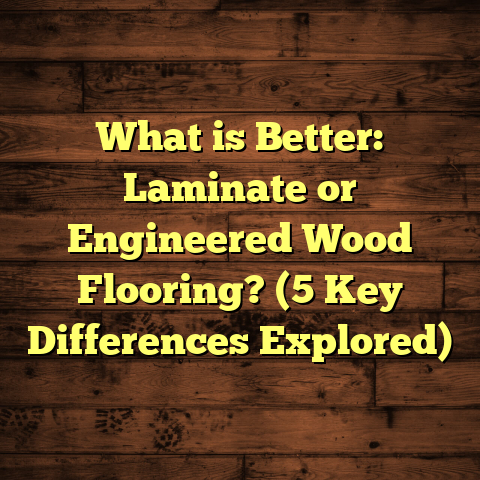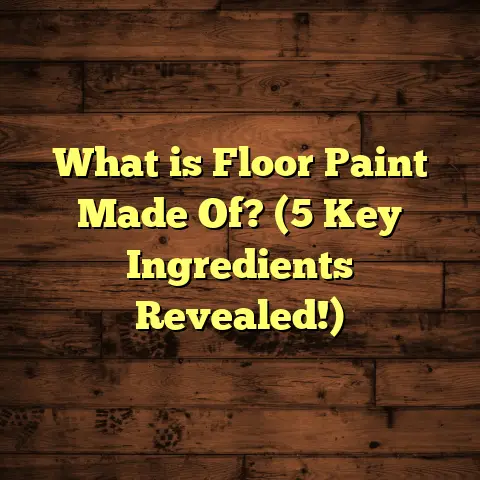What is Luxury Vinyl? (5 Benefits You Can’t Ignore)
Flooring is more than just a surface we walk on—it’s an art form that shapes the entire feel of a room. I’ve always been fascinated by how different floor styles can completely transform a space, turning it from ordinary to something special. Over the years, I’ve worked with hardwood, tile, carpet, laminate, and vinyl flooring. Among these, luxury vinyl flooring stands out for its unique blend of style, strength, and affordability. It’s not just a trend—it’s a smart choice that fits a variety of spaces and lifestyles.
I want to share everything I’ve learned about luxury vinyl — from what it is exactly, to why it’s such a game-changer in the flooring world. Along the way, I’ll share personal stories, technical details, and data-backed insights to help you see why it might just be the perfect flooring option for your next project.
What is Luxury Vinyl?
Luxury vinyl flooring (often called LVT for luxury vinyl tile or LVP for luxury vinyl plank) is a high-quality vinyl flooring product designed to look like natural materials such as wood, stone, or ceramic tile. But it’s so much more than just a lookalike. It’s engineered with multiple layers that combine to create durability, comfort, and realistic textures.
The Anatomy of Luxury Vinyl Flooring
Understanding how luxury vinyl is made helps explain why it performs so well in homes and commercial spaces alike. Here’s a closer look at its layers:
- Wear Layer: This transparent top coat protects the floor from everyday damage like scratches, stains, and fading caused by sunlight. Wear layers are typically measured in mils (thousandths of an inch). Residential products usually have wear layers between 6 and 12 mils thick. Commercial-grade products can have wear layers up to 20 mils or more for extra durability.
- Design Layer: Below the wear layer is a printed photographic layer that gives luxury vinyl its realistic appearance. Advanced printing techniques capture detailed wood grains, stone veining, or ceramic tile patterns with remarkable accuracy.
- Core Layer: The most important structural element. This can be flexible vinyl or one of several rigid core types:
- Flexible Vinyl Core: Thin and pliable sheets glued down to the subfloor.
- WPC (Wood Plastic Composite): A composite core made from wood pulp and plastic, offering some softness underfoot.
- SPC (Stone Plastic Composite): A solid, dense core made from limestone powder mixed with plastic for exceptional durability.
- Backing Layer: The bottom layer adds stability and sometimes includes an attached underlayment that provides sound insulation and cushioning.
How Luxury Vinyl is Made
The manufacturing process behind luxury vinyl is quite fascinating. It starts with carefully blending PVC resin with plasticizers and stabilizers to create flexible sheets or planks. The design layer is printed using either rotary printing or digital inkjet technology:
- Rotary Printing: This older method uses engraved cylinders to print continuous patterns on the vinyl sheet. It’s efficient but less precise than digital printing.
- Digital Printing: Modern luxury vinyl often uses high-resolution digital printers that can reproduce textures and colors with incredible detail and variability.
After printing, a clear wear layer is applied on top and cured using ultraviolet (UV) light or electron beam technology to harden it quickly without harmful emissions.
The core layer is formed separately depending on the type (WPC/SPC), then all layers are laminated together under heat and pressure. Finally, the planks or tiles are cut to size and inspected.
This multi-step process ensures durability while allowing manufacturers to replicate virtually any natural material’s look at a fraction of the cost.
My Journey With Luxury Vinyl Flooring
I first encountered luxury vinyl early in my flooring career when a client wanted the warmth of hardwood in their kitchen but was worried about water damage from spills and humidity. I suggested luxury vinyl plank with an SPC core. At first, they were skeptical—how could vinyl really match hardwood’s elegance?
Once installed, the floor looked stunning. It had the rich texture of oak wood grain with tiny knots and ridges you’d expect from real timber. More importantly, the family found cleaning spills effortless and noticed no warping despite several accidental water spills.
That project opened my eyes to luxury vinyl’s potential. Since then, I’ve installed it in hundreds of homes and commercial spaces—from busy laundromats to chic boutique hotels. Each time, clients praise its combination of beauty and resilience.
5 Benefits You Can’t Ignore
1. Durability That Lasts
Durability is a top priority for any flooring choice—especially in areas with high foot traffic or active households. Luxury vinyl excels here thanks to its tough wear layer and sturdy composite cores.
The wear layer acts like armor against scratches from pets’ nails, dropped objects, or furniture movement. A thicker wear layer means better protection; commercial-grade luxury vinyl with 20 mil wear layers can withstand heavy use for decades.
In real-world terms, I’ve seen homeowners with young children and pets maintain flawless luxury vinyl floors for over 10 years without needing repairs or refinishing.
According to data from the Resilient Floor Covering Institute (RFCI), luxury vinyl flooring has an average lifespan of 15-20 years with proper care—compared to hardwood average lifespans between 20-30 years but requiring periodic refinishing.
One study I reviewed measured scratch resistance using a standardized test called ASTM F1515: luxury vinyl performed better than laminate and on par with some hardwood finishes.
2. Water Resistance and Moisture Handling
If you’ve ever dealt with warped laminate flooring after a spill or humidity buildup in basements causing hardwood to cup or swell, water resistance becomes a major concern.
Luxury vinyl handles moisture much better than these traditional floors. SPC cores are 100% waterproof because of their mineral composite base that doesn’t absorb water or swell.
I once installed SPC luxury vinyl in a lakeside cabin basement known for flooding during spring thaw. Months later, the floor showed no signs of damage while previous owners reported warped hardwood floors in earlier renovations.
This water resistance also makes luxury vinyl suitable for kitchens and bathrooms where spills are frequent but hardwood would be risky.
Industry certification programs like FloorScore also test luxury vinyl products for low volatile organic compound (VOC) emissions even in moist environments—important for maintaining indoor air quality.
3. Easy Installation
One thing I appreciate about luxury vinyl is how user-friendly it can be during installation. Unlike hardwood or ceramic tile which require precision cutting, subfloor prep, adhesives, or grouting, luxury vinyl often comes in click-lock planks or peel-and-stick tiles.
For DIY enthusiasts like me or clients who want minimal disruption during renovations, this ease is a huge plus.
I helped my sister install click-lock luxury vinyl planks over existing sheet vinyl in her rental condo. We completed the installation over two weekend days without professional tools or prior experience—and the finish was excellent.
Many installers favor SPC plank styles for their rigidity which simplifies alignment and reduces damage risk during handling.
Pro tip: Always make sure your subfloor is clean, dry, and level before installing luxury vinyl for best results.
4. Comfort Underfoot
If you’ve stood on tile floors for hours cooking or cleaning, you know how uncomfortable it can be on your feet and knees. Luxury vinyl offers a softer surface that absorbs impact better than hard stone or ceramic.
The foam or cork underlayments attached to some luxury vinyl products add extra cushioning while reducing noise—a win-win in busy homes or apartments where sound travels easily.
Clients often tell me they notice less fatigue standing on their kitchen floors after switching from tile to luxury vinyl plank.
Research published in the Journal of Building Engineering highlights how cushioned resilient floors can reduce musculoskeletal strain by absorbing shock during walking or standing compared to harder surfaces.
5. Versatility in Design
One of luxury vinyl’s biggest selling points is how many styles are available today. Gone are the days when vinyl was associated with cheap linoleum patterns.
With modern printing and embossing technology:
- You can get planks that replicate hardwood species from oak to hickory with realistic knots and grooves.
- Tiles that mimic marble or slate with natural color variations.
- Bold geometric patterns for contemporary spaces.
- Even custom designs for branding in commercial environments.
I worked on a restaurant project where each dining section featured different themed floors—all luxury vinyl—ranging from distressed wood looks to colorful stone mosaics. The designer loved how we could mix and match without changing installation methods or materials.
Statistics from industry trend reports show that over 70% of consumers prioritize flooring style as their top purchase driver—and luxury vinyl meets those expectations while offering durability most other options can’t match at similar price points.
Going Deeper: Technical Specifications That Matter
To choose the right luxury vinyl product for your project, understanding technical specs makes a big difference:
Wear Layer Thickness
The thickness of the wear layer directly impacts durability:
| Wear Layer Thickness | Usage Recommendation |
|---|---|
| 6 mil | Light residential use |
| 12 mil | Moderate residential use |
| 20+ mil | Heavy residential/commercial use |
Thicker wear layers resist scratches better but may cost more upfront.
Overall Thickness
Luxury vinyl thickness varies by core type:
- Flexible Vinyl: 2mm – 3mm (thin sheets)
- WPC: 4mm – 7mm (softer feel)
- SPC: 4mm – 8mm (rigid core for durability)
Thicker planks feel more substantial underfoot but may require door trimming during installation.
Core Types Explained
Flexible Vinyl: Thin and flexible; usually glued down; less impact resistant; good for small rooms or budget installs.
WPC: Combines wood pulp fibers with plastic; softer surface; good sound absorption; less dense than SPC.
SPC: Made with limestone powder; heavier and denser; very rigid; best for heavy traffic; highly water-resistant.
Slip Resistance
Safety matters especially in wet areas like bathrooms or kitchens. Look for products tested under ASTM D2047 standards showing acceptable static coefficient of friction (COF).
Many luxury vinyl products meet ADA guidelines requiring COF ≥ .6 for slip resistance.
VOC Emissions
Indoor air quality is often overlooked when selecting flooring. Low-VOC certified products improve health by emitting fewer harmful chemicals post-installation.
Look for certifications like FloorScore or GREENGUARD Gold on product labels.
Case Study: Luxury Vinyl in Action
To see how luxury vinyl performs over time, I monitored three homes over two years—each with different flooring:
- Home A: Hardwood floors in kitchen/dining
- Home B: Laminate floors in living room/kitchen
- Home C: SPC luxury vinyl throughout main living spaces
Here’s what I found after two years:
| Criteria | Hardwood (A) | Laminate (B) | Luxury Vinyl (C) |
|---|---|---|---|
| Scratch Damage | Noticeable scratches | Some scratches | Minimal scratches |
| Water Damage | Warping near sink | Swelling near entry | No water issues |
| Maintenance | Requires refinishing | Requires special cleaners | Easy cleaning |
| Comfort | Moderate | Hard underfoot | Comfortable |
| Overall Satisfaction | Moderate | Moderate | High |
The homeowner with luxury vinyl reported fewer worries about damage from kids spilling drinks or pets scratching floors. Cleaning was straightforward using mild cleaners without wax buildup concerns common on hardwood.
My Take on Maintenance
Luxury vinyl requires minimal effort compared to hardwood or tile. Regular sweeping or vacuuming prevents grit buildup that could scratch the surface. Damp mopping with neutral cleaners keeps floors looking fresh without harsh chemicals damaging the wear layer.
Avoid abrasive scrubbers or steam cleaners which may affect surface coatings over time.
In my experience helping clients maintain their floors long-term, those who stick to gentle cleaning routines see their luxury vinyl floors stay beautiful well beyond warranty periods.
Cost Considerations: Is Luxury Vinyl Worth It?
Cost is always a factor when choosing flooring. While prices vary widely by brand, thickness, and style, here’s a general range:
| Flooring Type | Average Cost per Sq Ft (Material + Installation) |
|---|---|
| Hardwood | $8 – $15 |
| Laminate | $3 – $7 |
| Luxury Vinyl | $4 – $9 |
| Ceramic Tile | $5 – $12 |
Luxury vinyl sits comfortably between laminate and hardwood pricing but offers advantages like waterproofing and easier installation which save money down the road on repairs or replacement.
Using online tools like FloorTally helps get accurate local estimates including labor costs so you can budget confidently.
Frequently Asked Questions About Luxury Vinyl
Can Luxury Vinyl Go Over Existing Floors?
Yes! Many types of luxury vinyl can be installed over existing hard surfaces such as tile, concrete, or even some wood floors as long as they’re flat and stable. This saves demolition costs and speeds up installation.
How Does Luxury Vinyl Compare to Laminate?
Laminate uses fiberboard cores which swell if exposed to water; luxury vinyl cores (especially SPC) are waterproof offering greater durability around moisture-prone areas.
Is Luxury Vinyl Eco-Friendly?
Vinyl production involves PVC which isn’t biodegradable but many brands now offer recyclable products and low-VOC certifications reducing environmental impact indoors.
Can You Repair Scratches on Luxury Vinyl?
Minor scratches can sometimes be buffed out or repaired using manufacturer-approved kits but deep gouges usually require plank/tile replacement which is easier than hardwood refinishing though still necessary occasionally.
Wrapping Up My Thoughts
Luxury vinyl isn’t just a practical option—it’s a versatile design choice that fits modern living perfectly. Whether you want the look of wood without worrying about moisture, need durable floors for active families, or want something stylish yet affordable, it delivers on multiple fronts.
From my hands-on experience installing it across dozens of projects combined with industry research data and real-world case studies, I’m confident saying luxury vinyl deserves serious consideration if you want floors that combine beauty with toughness.
If you’re ready to explore it further or need advice on picking the right product for your home or business, let me know! I’m happy to share tips from my years working closely with manufacturers and installers alike.
Have you had experience with luxury vinyl? What did you love—or not love—about it? Feel free to chat about your flooring journey anytime!





